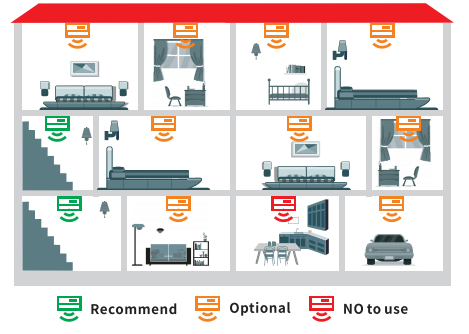EN
Language
All categories
Product ID: 62417891
carbon monoxide detector EN50291 standard with LCD display
Contact Now
Description
Testing for carbon monoxide (CO) is crucial for ensuring safety in both residential and industrial settings. Here are the common methods and tools used for CO testing:
1. Using Carbon Monoxide Detectors
The easiest and most common way to test for CO in homes is by using CO detectors. These devices are battery-operated and equipped with alarms to alert occupants when CO levels are dangerous. Key points to consider:
-
CO detectors should be installed on every level of the home and outside sleeping areas.
-
They should be tested monthly, and batteries should be replaced at least once a year, unless the device has a sealed 10-year battery.
2. Electrochemical Sensors
These sensors are widely used for measuring CO levels. They work by oxidizing CO at an electrode, generating an electric current proportional to the gas concentration. Benefits include:
-
High sensitivity and accuracy, even at low concentrations.
-
Low power consumption, making them suitable for portable and battery-operated devices.
3. Infrared (IR) Sensors
Infrared sensors detect CO by measuring the absorption of infrared light by CO molecules. This method is highly effective for continuous monitoring in industrial settings. Key advantages are:
-
High selectivity, minimizing interference from other gases.
-
Fast response time and long-term stability.
4. Metal Oxide Semiconductor (MOS) Sensors
These sensors use metal oxide materials that change resistance in the presence of CO. They are:
-
Cost-effective and durable in harsh environments.
-
Suitable for measuring a wide range of CO concentrations.
5. Chemical Colorimetric Tubes
These tubes contain chemicals that change color when exposed to CO, providing a visual indication of the gas concentration. They are:
-
Portable and easy to use, requiring no power.
-
Ideal for spot-checks and immediate results.
6. Professional Testing Equipment
For more accurate and comprehensive testing, especially in industrial settings or when diagnosing CO poisoning:
-
Combustion Analyzers: These tools measure CO levels generated by heating systems and other combustion appliances.
-
Pulse CO-Oximeters: Used by first responders to measure carboxyhemoglobin (COHgb) levels in the blood non-invasively.
-
Blood Gas Tests: In hospitals, arterial blood gas tests are used to measure CO levels in the bloodstream accurately.
7. Testing for CO Poisoning
If CO poisoning is suspected, immediate action is necessary:
-
Move all occupants to fresh air and call emergency services
-
Symptoms include headache, nausea, dizziness, and confusion
-
Medical imaging, such as MRI, may be used to assess potential brain or heart damage from chronic exposure
Regular testing and proper installation of CO detectors are essential for early detection and prevention of CO poisoning.
Product Features and Specifications
-
Power Supply
-
Battery Type: DC 3V (non-replaceable battery).
-
Battery Life: 10 years, ensuring long-term use without frequent replacements.
-
Initial Power-Up: The product has a 10-year lifespan from the moment it is first powered on.
-
-
Detection Technology
-
Sensor Type: Electrochemical Figaro CO Sensor, known for its high sensitivity and accuracy in detecting carbon monoxide.
-
Sensitivity Setting: Conforms to the BS EN 50291‑1:2018 standard, ensuring reliable detection and compliance with international safety regulations.
-
-
Alarm and Indicators
-
Alarm Signal: Loud (>85 dB(A)) audible alarm signal, ensuring it can be heard clearly at a distance of 3 meters.
-
Visual Indicators:
-
Power/Fault/Alarm indicator.
-
Visual LED for power status and alarm alerts.
-
End-of-life indicator to notify users when the device needs to be replaced.
-
-
-
User Interface
-
Test/Menu Button: Allows users to perform self-tests and access menu options for additional functionalities.
-
LED Display: Displays CO concentration in the range of 20 to 999 PPM (parts per million), providing clear and precise readings.
-
Low Battery Warning: Alerts users when the battery is nearing the end of its life, ensuring continuous protection.
-
-
Additional Features
-
Maximum Concentration Memory Function: Stores the highest CO concentration detected, useful for identifying peak exposure levels.
-
Sensitivity Setting: Configured to meet the BS EN 50291‑1:2018 standard, ensuring accurate detection and response to CO levels.
-
Product Parameter
|
Applicable place

key words:Battery Carbon Monoxide Alarm,10 years Carbon Monoxide Alarm,carbon monoxide detector EN50291
Contact Now
Please Send Message
${currentPro.title}
















